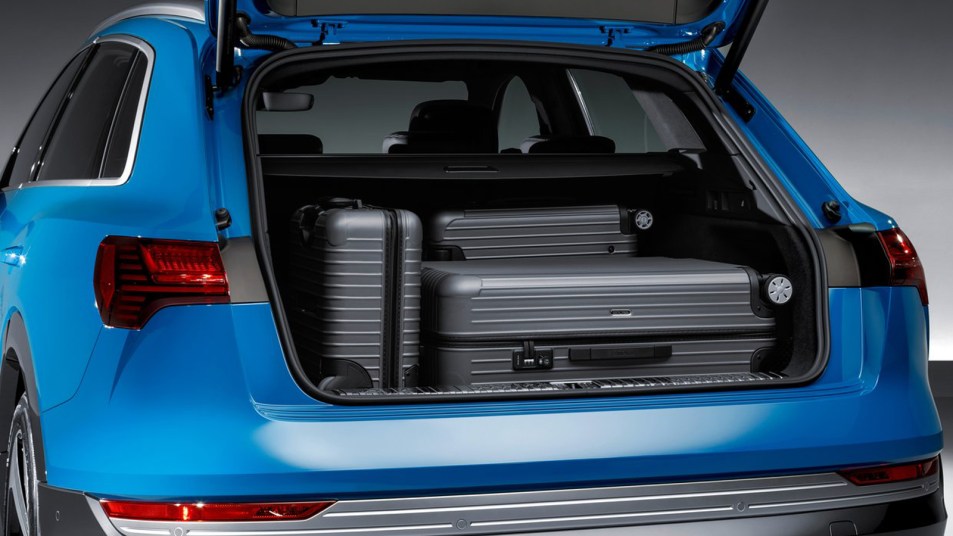Car Specs Quick Facts
- Car specs, short for specifications, are measurements and mechanical details found on the manufacturer’s website or vehicle’s window sticker.
- Specs provide insight into the car’s performance, driver and passenger comfort, and the cost of some features.
- Car specs to consider include horsepower, fuel economy, headroom, and more.
When researching a car for sale, the specs are a great place to start, but the terminology can be confusing. What exactly do manufacturers mean by wheelbase? How do you define headroom? Why are these details important?
Understanding the specs outlined below and how they can affect you as the potential owner of the vehicle can help save you time and ensure you get the right car for your lifestyle. In this article, we’ve researched key vehicle specs terms you’ll need to know about when making comparisons between competitors of cars, trucks, and SUVs. See the table of contents below.
- What Are Car Specs?
- Why Car Specs Are Important
- Approach, Departure, and Breakover Angles
- Cargo Volume
- Headroom
- Height
- Hip Room
- Legroom
- Length
- Shoulder Room
- Turning Circle
- Wheelbase
- Width
- Drivetrain
- Engine Displacement
- Miles Per Gallon
- Horsepower
- Torque
- 0-60 Speed
- Infotainment
- Airbags
- Electric Car Specs
What Are Car Specs?
Car specifications, or specs, highlight a vehicle’s essential measurements and mechanical details. This information is usually available on the manufacturer’s website or directly on the dealer sticker as you shop around the lot. There are three main types:
- Construction Specs: These refer to the physical build of the vehicle. Weight, width, cargo capacity, and wheelbase are all examples of construction specifications on a car.
- Performance Specs: These indicate how the vehicle will drive and perform regularly. Popular performance specifications include fuel economy, horsepower, and 0-60 speed.
- Operation Specs: Things like the audio system, safety features, and power-adjustable seats are all considered operational.
Why Car Specs Are Important
Car specs provide insights into various features. These details are how you determine if the car will fit your needs and lifestyle. If you regularly haul cargo, you may care more about the towing capacity. If you plan to take frequent road trips, fuel economy and interior comfort might be top priorities. Examining the specs helps you make a more informed purchase.
Additionally, the car specs reflect the sticker price and overall value. Different models and trim levels have distinct specifications that can create significantly divergent price points. When you compare specs, you can determine if certain features justify the car’s price and whether it’s worth working into your budget.
Where to Find a Car’s Specifications?
Car shoppers can find specs about the model on the automaker’s website, the vehicle’s window sticker, or a printed brochure.
Can I Use a VIN to Look Up a Car’s Specs?
Yes, you can get some information about the car by using the VIN. The Department of Transportation offers a VIN decoder through the National Highway Traffic Safety Administration. The lookup tool will provide essential information about the vehicle, including weight rating, drive type, transmission style, trim level, and more.
Approach, Departure, and Breakover Angles

Sometimes, searching for an SUV will turn up one or all of these three car spec terms. While they sound technical, they can be helpful.
- Approach angle is the angle of a hill an SUV can clear without scraping its front end.
- Departure angle is the same thing, just with the rear end.
- Breakover angle measures the angle between your vehicle’s underside and tires. That can be useful if you’re traversing an object and don’t want to scrape the bottom of your vehicle.
All three terms may be helpful to shoppers who enjoy off-roading — or even those with a steep driveway.
Cargo Volume

Cargo volume car spec is the total cubic feet of space in a car’s cargo area. In SUVs, minivans, and hatchbacks, this measurement is often given twice — one with the rear seats up and a second with the seats folded down. That gives drivers an idea of available cargo space for a family trip and the possible volume for an occasional trip to the furniture store.
Headroom

The measurement of headroom is the distance from a vehicle’s roof to the seat bottom. (A more appropriate name might be “torso room.”) Sometimes, you’ll see maximum and minimum values for this car spec published since most automobiles have seats that adjust up and down.
Height
Height, like length, is a simple measurement. This vehicle spec measures the distance from the car’s lowest point to its tallest point. Knowing a car’s height can be helpful if you have a tight garage or commonly park in a place with low ceilings. Also, be aware of the height of an opened liftgate on hatchbacks and SUVs. If you’re a full-size pickup truck owner, knowing the vehicle’s height becomes especially important.
Hip Room

Hip room defines the width of the front bucket seat bottom. In the back, it’s the width of the seat bottom divided by three (if three passenger seating is available). If it’s captain’s chairs, use the seat bottom measurement.
Legroom

While it might seem like an easy one, legroom is one of the most complicated automotive measurements. Legroom can be controversial: Should you measure it with the front seats all the way forward or back? The Society of Automotive Engineers — the organization responsible for horsepower ratings — uses one consistent measuring system. But it doesn’t give much insight into exactly how much room a driver or passenger has. As a result, we suggest sitting in a car before buying if legroom is a significant concern.
Length
The length measurement is probably the easiest of all the car specs. As its name implies, it’s just the distance from a car’s front tip to the farthest point in the back.
Shoulder Room

Although shoulder room is rarely measured, it can be important for shoppers who often carry passengers in the car. It’s the measurement from one door panel to another. That’s different from the vehicle’s hip room, which measures a single seat. And it’s different from width since the car’s shoulder room measures its interior, which is usually much narrower.
Turning Circle
The car’s turning circle describes the diameter of the smallest U-turn a vehicle can make. For example, if its turning circle is 37 feet, it takes 37 feet curb-to-curb to complete a U-turn. A smaller turning circle can be essential to drivers who live in narrow urban areas where tight turns are the norm.
Wheelbase
The wheelbase is the distance between the center of the front and rear wheels. While the wheelbase won’t tell you how long a car is, it roughly measures the size of the passenger compartment and may give you an idea of how big the interior is.
Width

The width measurement can be tricky for drivers with a narrow garage. A car’s width defines its widest point without its mirrors. That means a vehicle only a few inches narrower than your garage will give you a tighter squeeze than you realize. After all, even if you fold in the mirrors, you’ll still have a few extra inches on each side.
Drivetrain
The drivetrain is the system that transfers power from the engine to the wheels. This spec tells you how the vehicle will drive and behave as you navigate different road conditions. Typical configurations are front-wheel drive (FWD), rear-wheel drive (RWD), all-wheel drive (AWD), and 4-wheel drive (4WD).
- Front-wheel drive: Most of the power transfers to the front wheels. This system is usually the most compact and cost-efficient.
- Rear-wheel drive: Most of the power transfers to the rear wheels. These systems tend to have improved handling and more effective weight distribution.
- All-wheel drive: Similar to 4-wheel drive, an AWD drivetrain distributes power to all four wheels as needed for better stability and traction control. AWD systems are great for light off-road driving and driving on slippery roads.
- 4-wheel drive: Engaging 4WD mode for off-road driving locks the vehicle’s axles together so the front and rear wheels turn at the same speed. While specialty systems exist, using typical 4WD on dry pavement can cause serious damage.
Engine Displacement
Also known as engine capacity, engine displacement is the total volume of all the cylinders in an internal combustion engine. Usually measured in liters (L) or cubic centimeters (cc), displacement speaks to the size and potential power output. Larger-volume engines can generate more power.
Miles Per Gallon
Fuel efficiency is measured by the number of miles gas-powered vehicles can drive on a single gallon of fuel. This specification is an estimated average based on optimal driving conditions. Actual mpg numbers will vary.
Horsepower
Often shortened to “hp,” horsepower is a term that compares the power of an engine to that of a horse. It measures the energy output of your engine. The higher the horsepower number, the more power the engine will produce.
Torque
Torque is what makes your car accelerate. It’s the twisting force that propels the vehicle forward; the higher the number, the more power it has to advance. Sports cars and performance vehicles typically have more torque than commuter cars. Trucks used for towing usually have significant torque. Since torque can affect your gas mileage, look for something with a lower output if fuel efficiency is a top priority.
0-60 Speed
The term “0-60” signifies how quickly the car can go from a standstill to driving at 60 miles per hour (mph). This timed measure of acceleration is a key performance indicator for speed enthusiasts and sports car drivers. It signals the engine’s horsepower and torque capabilities.
Infotainment System

Car shoppers often find measurements and connectivity capability listed for vehicle infotainment systems. These integrated media systems deliver information and provide entertainment functionality. Early generations of small display screens have evolved into today’s large digital interactive touchscreens that serve as the control panel for navigation, cabin climate control, audio volume, mobile phone integration, and other preferences.
Airbags
Since 1998, United States law has required all new vehicles to have front airbags for the driver and front passenger. When sensors detect a collision, these passive car safety devices rapidly inflate to protect the occupants. Today, four kinds of airbags are available in domestic automobiles: Front airbags, side-impact airbags, knee airbags, and side-curtain airbags.
Electric Car Specs
Most electric vehicles (EVs) have the same or similar specs as gas-powered cars. However, there are a few key differences. Here are some expected EV specs to consider:
- MPGe: This stands for miles per gallon of gasoline equivalent. MPGe, a unit of measurement established by the Environmental Protection Agency (EPA), refers to the car’s energy consumption level. It measures the number of miles a vehicle can travel on electric power equal to the amount of energy a gallon of gasoline can produce.
- Range: This is the distance an EV can drive on a single charge. EVs with lower range specs must be recharged more often than those with longer ranges.
- Regenerative Braking: Instead of using friction to slow down the vehicle, like in a hydraulic braking system, regenerative brakes use the electric motor to stop the car. The kinetic energy it generates while slowing helps preserve the EV’s range.
- Kilowatt-Hour (kWh): A kilowatt-hour is a unit used to measure the energy consumption rate of an EV battery. This is an important spec to look at when evaluating an electric car’s battery capacity and energy efficiency.
Editor’s Note: This article has been updated since its initial publication.











Car measurements are not realistic generally. For example I have a 2012 Dodge Avenger that lists the “hip room” as 52.6 inches. This measure includes the width of the center console where a passenger’s hip can not be. I measured the actual space provided from the inside of the door panel where my hip rests to the inside of the center console and the measure was 23 inches. Assuming the passenger measure is the same, that is an actual hip room measure of 46 inches, a full 6.6 inches short of the advertised area. This becomes important when your carriage is above the norm.
You must have center ground clearance of vehicle to calculate breakover angle and none of the specs online show that.
they do not measure the drivers seat for some stupid reason
Probably the same stupid reason a garage only a few inches wider than a car seems no problem for this brain-dead writer. Lacking enough side clearance to open doors, journalists must be perfectly happy living out their remaining years in the car, unable to exit. Falling every year since 1963, national average SAT scores speak volumes to why good manufacturing jobs fled the United States. All the lights may be on, but no one is home!
how to judge the impact of a bounce by the cars? Can you suggest cars having very minimal affect of a road on the passengers passing over the bouncy terrain.